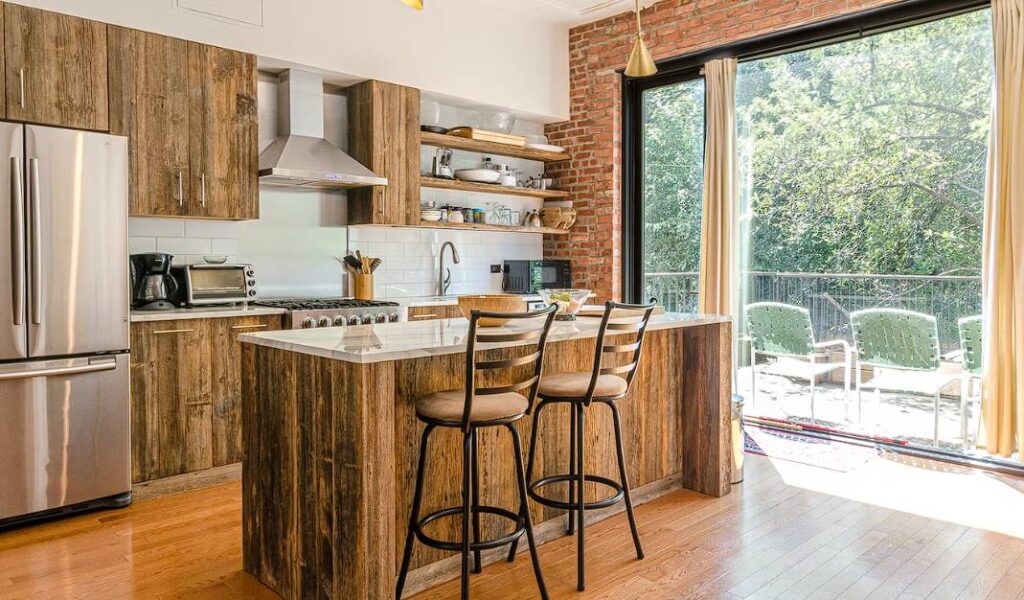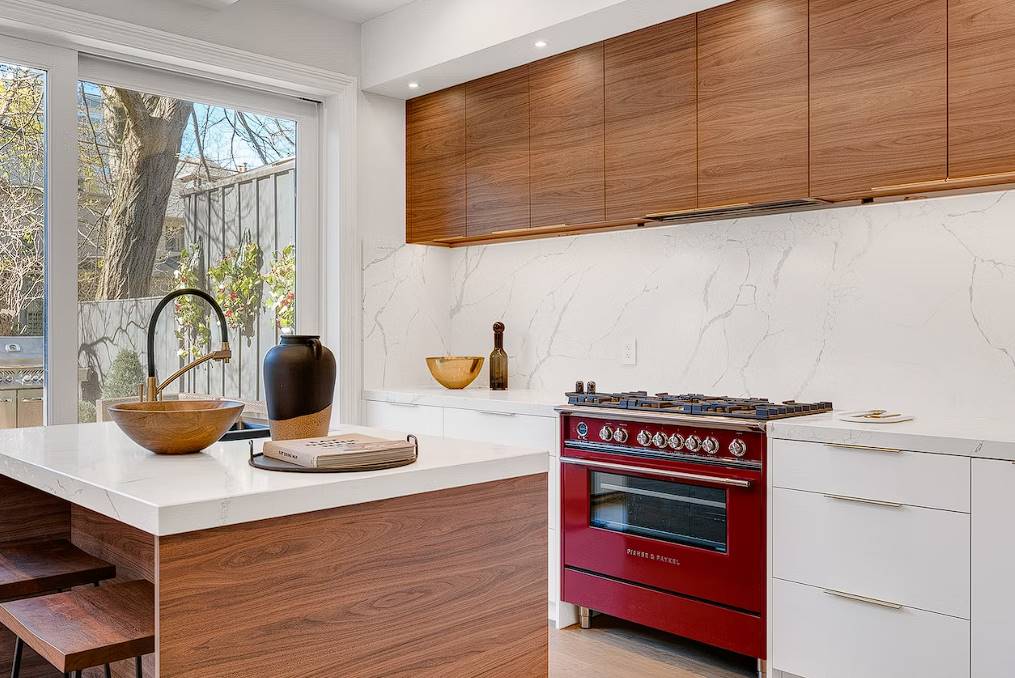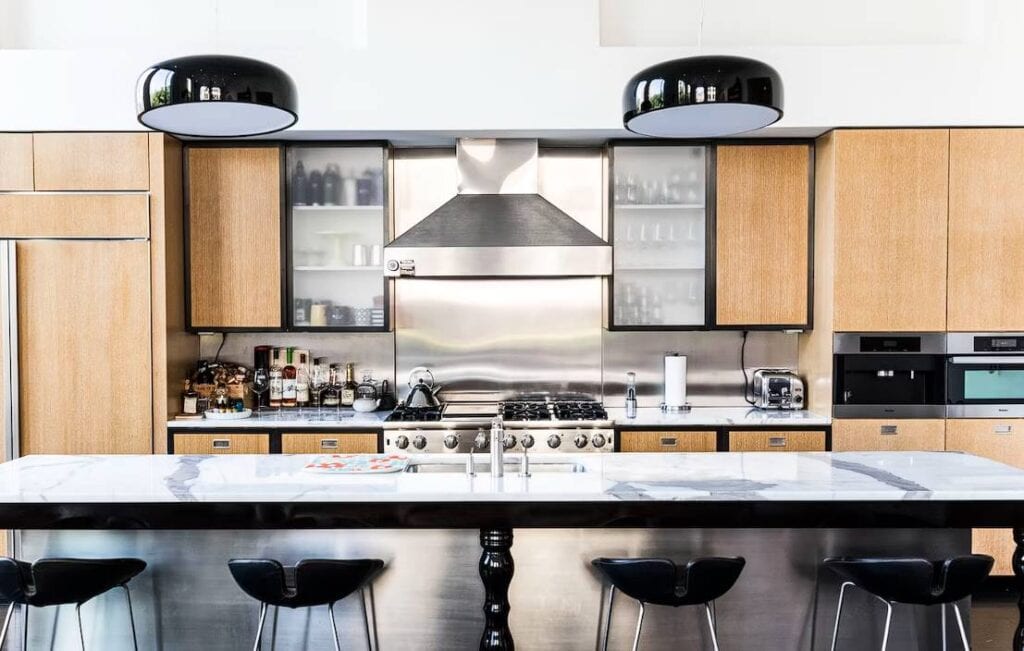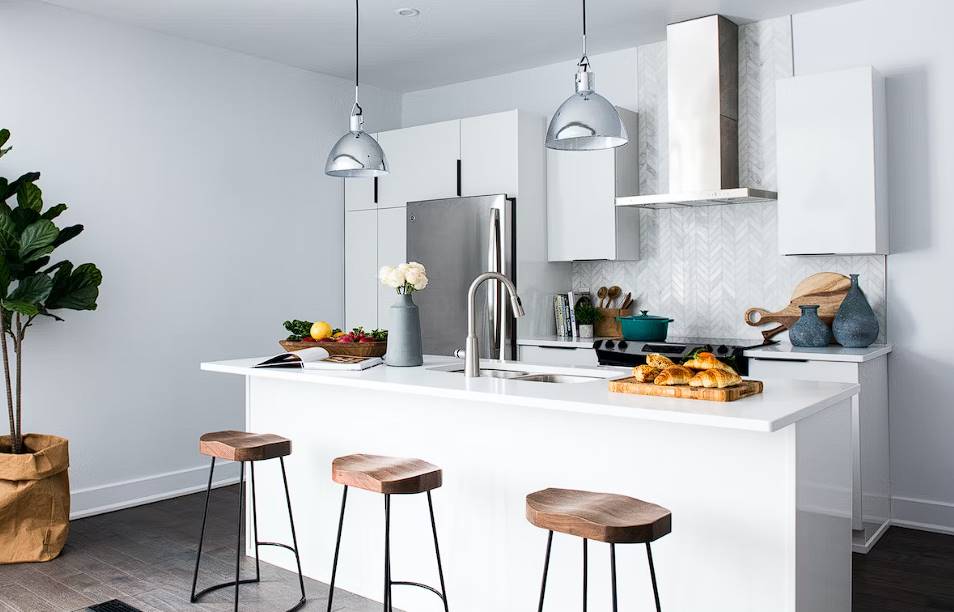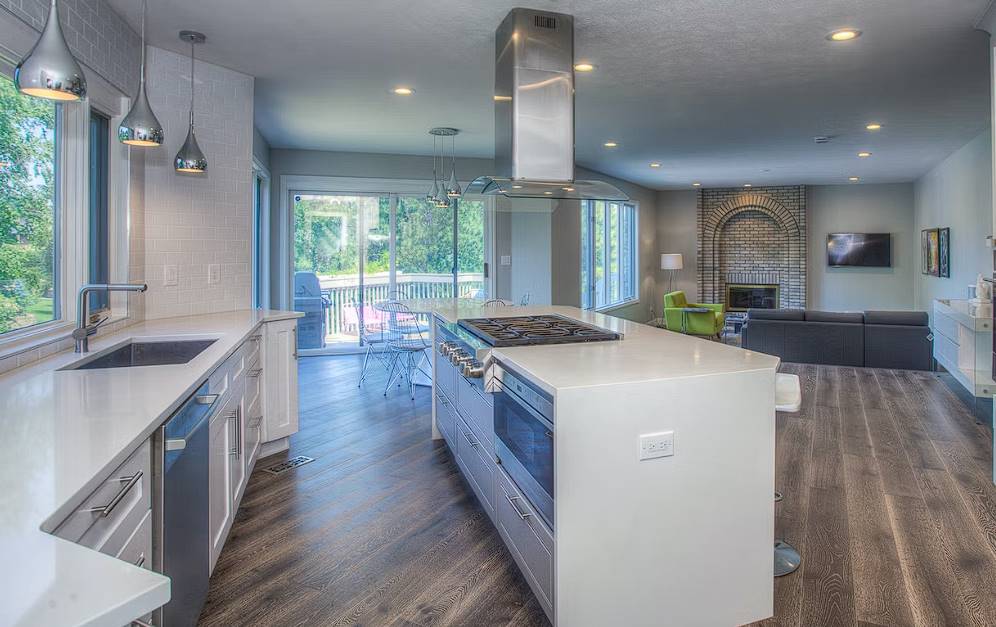Cabinet refacing is one of the least expensive ways to give your kitchen a brand-new look. Instead of spending a lot of money on new cabinets or hiring workers to build custom ones, you save a lot of money by doing this. Like many do-it-yourself home improvement projects, kitchen cabinet refacing can appear simple at first glance but is quite involved. The first step in refacing and measuring your cabinets is trickier than it seems at first glance.
When refacing kitchen cabinets, how should you take their measurements? Organising your cabinets is the first order of business. First, individually get the width and height dimensions of the opening, interior, overlay, door, inner corners, and details. Then, take advantage of a cabinet when taking measurements by following the wrong order.
What Is Cabinet Refacing?
Only the cabinets' fronts and associated hardware are replaced during a cabinet refacing project, while the cabinet boxes remain in place. It gives the cabinets a brand-new look without requiring extensive demolition and reinstallation, making it a more cost-effective option than replacing them entirely.
The appearance of your kitchen can be drastically altered by simply replacing the cabinets' external components, such as the doors and hardware. There is a great deal of leeway in terms of aesthetics when it comes to cabinet refacing. It's a common option for people who want to modernise their kitchens without the expense, mess, and hassle of replacing the cabinets entirely.
Methods For Measuring Kitchen Cabinets For Refacing
The "skin" of the cabinet gets swapped out when you reface kitchen cabinets. In the end, it will be restored to a brand-new condition. Get the right measurements for your kitchen cabinets with these easy-to-follow instructions.
Tools Required For Preparation
Prepare the things you need right away, so you won't be interrupted while taking measurements:
- Paper
- Tape measure
- Pencil
Draw A Simple Sketch Of Your Kitchen Cabinet
Even a rough kitchen cabinet layout design might help you stay on track. In addition, it helps you organise your cabinets neatly. Make sure your drawing is detailed enough to accurately label your kitchen cabinet's various components, including their sizes.
Breadboards, mouldings, and other embellishments may set your kitchen cabinetry apart. Include the specifics, such as whether or not you have a divider in the middle of your double-door cabinets and the handles and hinges on your drawing. Two-door cabinets are joined when an X or dotted line is drawn between them. If you can read the sign, any symbol will do.
Determine How To Measure A Kitchen Cabinet
With so many different compartments, entrances, and doors, it's easy to lose track of space and forget some measurements. Keeping your kitchen cabinet measurements in a logical order will help you stay on track. Most people work their way from left to right and top to bottom of the kitchen cabinets. So following that sequence, the leftmost area of your cupboard will be your starting point.
Height, Width, And Length Should All Be Measured.
Before considering the height of the cabinet, determine its width. If you start by measuring the kitchen's width, you can visualise how the cabinets will be installed in accordance with industry standards.
Measure The Components.
There are other considerations to make when remodelling your kitchen; for example, your kitchen cabinet contains additional features. Take careful measurements of the following items in your kitchen cabinet.
Opening
First, you'll need to measure the opening in your kitchen cabinets. When a kitchen cabinet door is opened, you'll find a space of this dimension. Before determining the height from the ground up, measure the width or how far it is from left to right.
Cabinet Drawers
To ensure that your drawers will fit in your cabinets, measure the width and height of the opening on the inside of each drawer. The drawer faces could be completed ahead of the drawer box. Get precise dimensions of the overlay's inner corners.
If you would like to alter the design of the drawers in your kitchen, measure the backside so that the measurement is as close as possible to 1/16 of an inch.
Knobs or Handles
Think about where the knobs or handles, of whatever design, will go, and include that in your measurements. Then, measure both the knob and the hole in your cabinets.
Hinges
To avoid damaging the hinges when applying wood veneer or another refinishing material, carefully map out their locations.
Cabinet Frame
The cabinet's frame serves as its skeleton. Consider the following dimensions in terms of height, width, and length:
- Toe-kick
- Face frame rail
- Cabinet rail/stile
- End panel width
- Cabinet face frame style
Doors
Recognise the door style of your cabinets. Double-door cabinets and single-door cabinets are the most typical types. However, when it comes to shutting an entrance, three distinct styles of doors can be identified:
- Overlay doors are designed to rest in a space above or beyond the cabinet frame, beyond the cabinet opening. Inch door overlays are the norm.
- Inset –The edge of the door flushes with the opening in the frame, so the cabinet doesn't stick out or get in the way.
- 3/8 inches –The door overlays the frame in some places, and some parts are custom-made to fit the opening.
The door of your kitchen cabinets should be measured to within 1/16 of an inch. When calculating the door overlay, the extra width could present a challenge. Take precise measurements of door frames, including interior angles and space. Overlays are typically an inch larger than the openings they cover.
Consider Obstructions.
As you stick your refacing material, remember that you'll have to work around the sink, appliances, windows, and other features.
Measure The Interior Of The Cabinet
Take accurate measurements of your kitchen storage cabinets' depth, width, and height. These are the compartments within your storage cabinets. Take accurate measurements of your kitchen storage cabinets' depth, width, and height. These are the compartments within your storage cabinets.
Measurements Should Be Double-Checked
Your time, money, and energy will all be well-spent if you don't measure your kitchen cabinets properly. Kitchen cabinet measurements are important, so double-check to be sure you have them right. Having someone else take down the measurements as you dictate them saves time.
Pros Of Refacing Kitchen Cabinets
If you want to refresh your kitchen's aesthetic without spending much money or time on new cabinets, consider cabinet refacing. As a result of its low price and numerous advantages, this replacement is rapidly replacing the traditional kitchen remodel. In this article, we'll go over the benefits of cabinet refacing and why it might be the best option for your kitchen remodel.
Quick Remodel Solution
If you want to give your kitchen a fresh look without spending much time and money remodelling, cabinet refacing is a great option.
Inexpensive
The low cost of refacing kitchen cabinets is one of its most prominent benefits. If you want to replace your cabinets but want to save money doing so, consider replacing their veneers.
Maintain The Same Layout.
If you are satisfied with the layout of your current kitchen, it would be more cost-effective to refinish your cabinets rather than replace them. However, you can keep the existing layout without reorganising your kitchen or installing new cabinets during refacing.
Maintain Your Original Cabinet Frames.
The fact that the cabinet shells can be reused is another selling point for refacing over replacement. Strengthening your existing cabinets through refacing can help you get the most out of them.
More Environmentally Friendly
If you are worried about the environment, refacing is a fantastic alternative to demolition and construction. By reusing "vintage" furniture styles rather than buying brand-new ones, you can save trees and keep your cabinet boxes out of landfills.
Can Improve The Appearance
The flexibility to experiment with your kitchen's aesthetic is another advantage of refacing your cabinets. Many types of veneer exist, so you can experiment with different looks until you find the one that works best for your kitchen.
Keeps Remodelling To A Minimum
Also, let's say you're content with the current cabinetry in terms of both storage and organisation. If this is the case, it is reassuring to know that cabinet refacing does not require any modifications to the interiors of your cabinets.
Cons Of Refacing Kitchen Cabinets
Kitchen cabinet refacing can be enticing because it allows you to update your kitchen's appearance without the expense and disruption of a full replacement. It'sHowever, there may be better options than cabinet refacing for all homeowners. To help you make a well-rounded decision about your kitchen remodel, we'll go over some of the disadvantages of refacing your cabinets here.
The Installation Of Veneer Is Not Free.
Wood veneers are appealing to many people and may appear inexpensive at first glance, but their installation may be more labour-intensive and expensive than expected.
Does Not Expand Storage Capacity
Some may also decide replacing their cabinets is the best option because they are unhappy with their storage. The insides of your cabinets will remain unchanged, but the exteriors will be updated with cabinet refacing.
Let's say you're not happy with your current kitchen cabinets because you want more storage space, but there don't need to be more shelves, or the drawers need to be in the right place. If that is the case, consider replacing your cabinets with new ones.
Professional Installation May Be Required For An Appealing Finished Design.
Applying veneers is another challenging task. If you don't apply the veneer correctly, you may end up with cabinets that look even worse than they did before.
The Layout Remains Unchanged.
Refacing kitchen cabinets has some drawbacks if you want to update your kitchen's appearance. One problem with refacing your current kitchen cabinets is that it won't allow you to change the layout.
If you want to remodel your kitchen because of space issues, you'll need more than new cabinet fronts to make it work. Instead, remove the current cabinets and rearrange the room to create the necessary space.
New Cabinets May Increase Resale Value More Than Used Cabinets.
Kitchens with wood veneers look like they were made of solid wood, but they may need to be stained or varnished to get this look. On the other hand, kitchens with natural wood cabinets can increase the value of your home, and it is likely cheaper overall in the long run.
Does Not Add To Counter Space
Looking for and installing new cabinets is also suggested if you need more storage in the kitchen.
The main drawback of cabinet refacing is that it does nothing to repair the cabinet's underlying structure. Therefore, if the cabinet box is damaged, refacing won't improve the situation or significantly lengthen the life of the cabinets.
Not All Kitchen Cabinet Types May Be Suitable For Refacing.
Veneers also require a smooth surface to cling to properly. If the veneer sticks to your cabinets, you will have spent your time and money on a project that will not improve the quality of your home for the long term.
Common Mistakes In Kitchen Cabinet Measurement
Common mistakes include failing to verify measurements, overlooking overlay details, and misreading dimensional measurements. Remembering these details will help you avoid having to make the same adjustments to your kitchen cabinets twice.
Ignoring The Dimensions Of Measurements
Take note of the units of measurement that you are currently employing. Recording them either digitally or by hand on paper will help you avoid confusing the two of them.
Forgetting About The Overlay
Pay more attention to the overlay when trying to simplify the appearance of the drawers in your kitchen cabinets. For example, wood veneers can be cut too short or long, resulting in non-functioning cabinet doors.
Failure To Double-Check Measurements
Suppose you made a mistake in measuring before cutting your wood veneers and quickly realised it. It certainly seems problematic. If you are concerned that you may have made a mistake in your sizing, checking your measurements twice will allow you to make the necessary adjustments.
Conclusion
Cabinet refacing is one of the least expensive ways to give your kitchen a brand-new look. It involves taking measurements of the opening, interior, overlay, door, inner corners, and details. The "skin" of the cabinet gets swapped out when you reface kitchen cabinets, making it a more cost-effective option than replacing them entirely. Tools required for preparation include paper, tape measure, pencil, and a sketch of your kitchen cabinet layout design. A rough kitchen cabinet layout design can help you stay on track and organise your cabinets neatly.
The most important details in this article are the benefits and disadvantages of refacing kitchen cabinets. These include the low cost of refacing, the flexibility to experiment with the kitchen's aesthetic, the ability to keep the existing layout, the ability to maintain the original cabinet frames, the ability to save trees, the ability to improve the appearance, and the ability to keep the interiors of the cabinets unchanged. Additionally, the installation of veneer is not free, so it may be more labour-intensive and expensive than expected. Additionally, the installation of wood veneers may be more labour-intensive and expensive than expected. Finally, the installation of wood veneers may be more labour-intensive and expensive than expected, and the ability to keep the existing layout, the ability to maintain the original cabinet frames, the ability to save trees, and the ability to keep the interiors of the cabinets unchanged.
Content Summary:
- Cabinet refacing is one of the least expensive ways to give your kitchen a brand-new look.
- Like many do-it-yourself home improvement projects, kitchen cabinet refacing can appear simple at first glance but is quite involved.
- The first step in refacing and measuring your cabinets is trickier than it seems at first glance.
- When refacing kitchen cabinets, how should you take their measurements?
- Organising your cabinets is the first order of business.
- Then, take advantage of a cabinet when taking measurements by following the wrong order.
- Only the cabinets' fronts and associated hardware are replaced during a cabinet refacing project, while the cabinet boxes remain in place.
- The appearance of your kitchen can be drastically altered by simply replacing the cabinets' external components, such as the doors and hardware.
- There is a great deal of leeway in terms of aesthetics when it comes to cabinet refacing.
- The "skin" of the cabinet gets swapped out when you reface kitchen cabinets.
- Get the right measurements for your kitchen cabinets with these easy-to-follow instructions.
- Prepare the things you need right away, so you won't be interrupted while taking measurements: Paper Tape measure Pencil Draw A Simple Sketch Of Your Kitchen Cabinet Even a rough kitchen cabinet layout design might help you stay on track.
- In addition, it helps you organise your cabinets neatly.
- Make sure your drawing is detailed enough to accurately label your kitchen cabinet's various components, including their sizes.
- Breadboards, mouldings, and other embellishments may set your kitchen cabinetry apart.
- Include the specifics, such as whether or not you have a divider in the middle of your double-door cabinets and the handles and hinges on your drawing.
- With so many different compartments, entrances, and doors, it's easy to lose track of space and forget some measurements.
- Keeping your kitchen cabinet measurements in a logical order will help you stay on track.
- Most people work their way from left to right and top to bottom of the kitchen cabinets.
- So following that sequence, the leftmost area of your cupboard will be your starting point.
- Before considering the height of the cabinet, determine its width.
- If you start by measuring the kitchen's width, you can visualise how the cabinets will be installed in accordance with industry standards.
- Take careful measurements of the following items in your kitchen cabinet.
- First, you'll need to measure the opening in your kitchen cabinets.
- To ensure that your drawers will fit in your cabinets, measure the width and height of the opening on the inside of each drawer.
- Get precise dimensions of the overlay's inner corners.
- If you would like to alter the design of the drawers in your kitchen, measure the backside so that the measurement is as close as possible to 1/16 of an inch.
Frequently Asked Questions
The duration of the cabinet refacing process depends on various factors, such as the size of your kitchen and the project's complexity. On average, completing the refacing process can take anywhere from a few days to a couple of weeks.
Cabinet refacing primarily focuses on updating the external appearance of the cabinets. It does not involve altering the layout or structure of the cabinets. Additional modifications or a complete cabinet replacement may be necessary if you wish to change the layout.
While refinishing cabinets involves applying a new finish to the existing cabinet surfaces, refacing involves replacing the doors, drawer fronts, and hardware. Refinishing is a more budget-friendly option, but it is limited to cabinets in good structural condition and may offer different transformative results than refacing.
Cabinet refacing requires a certain level of skill and knowledge. While it is possible to DIY, hiring a professional for a seamless and professional result is often recommended. They have the expertise, tools, and experience to ensure precise measurements, proper installation, and a high-quality finish.
The durability of the new finish depends on the quality of materials used and how well it is maintained. However, with proper care and regular cleaning, the refaced cabinets can maintain their appearance and functionality for many years.

